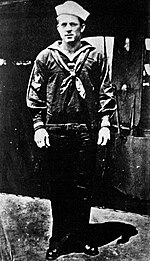Osmond Kelly Ingram
| Osmond Kelly Ingram | |
|---|---|
 
Osmond Ingram, Medal of Honor recipient
|
|
| Born |
August 4, 1887 Oneonta, Alabama |
| Died | October 15, 1917 (aged 30) Celtic Sea |
| Allegiance |
|
| Service/branch |
|
| Years of service | 1903 - 1917 |
| Rank | Gunner's Mate First Class |
| Unit | USS Cassin |
| Battles/wars |
World War I *Atlantic U-boat Campaign *Action of 15 October 1917 |
| Awards | Medal of Honor |
Osmond Kelly Ingram (August 4, 1887 – October 15, 1917) was a sailor in the United States Navy during World War I who received the Medal of Honor posthumously.
Born to Robert L. Ingram and his wife Naomi Elizabeth Lea in Oneonta, Alabama, Ingram entered the Navy November 24, 1903. His ship, USS Cassin, was attacked by the German submarine U-61 off Ireland on October 15, 1917. Gunner’s Mate First Class Ingram spotted the approaching torpedo, realized it would strike close by the ship's depth charges, thus dooming the ship, and rushed to jettison the ammunition. He was blown overboard when the torpedo struck, thus becoming the United States' Navy's first enlisted man killed in action in World War I as he attempted to save his ship and shipmates. He posthumously received the Medal of Honor for his actions on that day.
The main flagpole and colors at the former Naval Training Center, San Diego are named Ingram Plaza in his honor
USS Osmond Ingram (DD-255), a Clemson-class destroyer, served in the United States Navy during World War II. Osmond Ingram was decommissioned at Philadelphia on January 8, 1946 and was struck from the Navy List on January 21, 1946. It was sold for scrapping to Hugo Neu June 17, 1946.
Kelly Ingram Park is also named in his honor. It is a 4-acre (1.6 ha) park located in Birmingham, Alabama.
Rank and organization: Gunner's Mate First Class, U.S. Navy. Born: August 4, 1887, Alabama. Accredited to. Alabama.
Citation:
For extraordinary heroism in the presence of the enemy on the occasion of the torpedoing of the Cassin, on 15 October 1917. While the Cassin was searching for the submarine, Ingram sighted the torpedo coming, and realizing that it might strike the ship aft in the vicinity of the depth charges, ran aft with the intention of releasing the depth charges before the torpedo could reach the Cassin. The torpedo struck the ship before he could accomplish his purpose and Ingram was killed by the explosion. The depth charges exploded immediately afterward. His life was sacrificed in an attempt to save the ship and his shipmates, as the damage to the ship would have been much less if he had been able to release the depth charges.
...
Wikipedia
